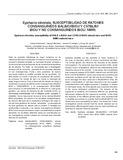Syphacia obvelata, Susceptibilidad de Ratones Consanguíneos BALB/C//BIOU y C57BL/6//BIOU y no Consanguíneos BIOU: NMRI.

Visualizar/
Data
2017-11Palabras Clave
BALB/c//BIOU, C57BL/6//BIOU, Ratones consanguíneos, BIOU: NMRI, Ratones no consanguíneos, Parasitosis, Syphacia obvelataSyphacia obvelata, BALB/c//BIOU, C57BL/6//BIOU, Inbred mice, BIOU: NMRI, Outbred mice, Parasited
Metadatos
Mostrar registro completoResumo
Entre los parásitos intestinales de mayor incidencia en los ratones de laboratorio producidos en bioterios convencionales, se encuentra
Syphacia obvelata. La respuesta de estos animales a la presencia del parásito depende de las características genéticas de los mismos.
Por tanto, es conveniente que el investigador conozca cuál es la posible respuesta de los animales utilizados en sus investigaciones,
frente a esta parasitosis de manera que pueda realizar un análisis acertado de sus resultados. En este estudio se evaluó el periodo de
prepatencia del parásito, se evaluaron los niveles de IgG y se evaluó la histología del ciego (órgano blanco). Para el desarrollo del
estudio se indujo la parasitosis a un grupo de ratones sanos consanguíneos: BALB/c//BIOU y C57BL/6//BIOU, y no consanguíneos: BIOU:NMRI,
para comparar la susceptibilidad de la infección en cada grupo genético. Los valores de titulación de IgG mediante ELISA, en
microplacas sensibilizadas con el antígeno crudo (parásito S. obvelata), fueron mayores en los sueros de los ratones BALB/c//BIOU
parasitados. En relación a los resultados histopatológicos, se observó alteración de la arquitectura histológica del ciego en los
tres tipos genéticos de ratones estudiados. La respuesta de los tipos genéticos de ratones ante el parásito S. obvelata son
conducentes a presentar a los ratones consanguíneos BALB/c//BIOU como los que presentaron mayor susceptibilidad al parásito estudiado,
los resultados obtenidos deben ser considerados por los investigadores cuando trabajan con animales que presentan este tipo de parasitosis.
Colecciones
Información Adicional
| Otros Títulos | Syphacia obvelata, susceptibility of BALB /c/BIOU and C57BL/6/BIOU inbred mice and BIOU: NMRI outbred mice |
| Correo Electrónico | rosadej@ula.ve |
| Editor | Saber ULA |
| ISSN | 0798-2259 |
| ISSN Electrónico | 2477-944X |
| Resumen en otro Idioma | Syphacia obvelata are the parasites of major incidence in the mice of laboratory within of animal conventional facilities. The animal genetic can influence the response to the studied microorganism. The researcher may have precision of the results analysis of your investigations, when he has understanding of the infections natural of the animals. In this assay, the susceptibility was compared between BIOU:NMRI outbred mice and BALB/c//BIOU and C57BL/6//BIOU inbred mice, those were parasited and measured: prepatent period, IgG title and cecum histology. The worm and eggs first were observed in BALB/c//BIOU mice, the higher concentrations of IgG were observed in the micro plates sensibilized with crude antigen (parasite S. obvelata). In relation to histological assay, the three genetic type presented alteration of the cecum histological architecture. The behavior of the organisms to situations environmental different are genetically determined, between this the response to parasites. In this study the response of the different genetic types mice parasited with S. obvelata are conduce to consider that the BALB/c//BIOU mice inbred have more susceptibility to these. The researcher in their investigations should consider that the results obtained can be altered when different genetic type’s mice are used and these are parasited by naturally intestinal parasites. |
| Colación | 366-374 |
| País | Venezuela |
| Institución | Universidad del Zulia (LUZ) Universidad de Los Andes (ULA) |
| Publicación Electrónica | Revista Científica |
| Sección | Revista Científica: Medicina Veterinaria |





